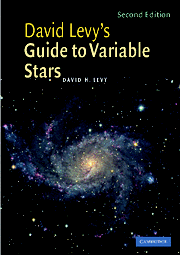Book contents
- Frontmatter
- Contents
- Foreword to the first edition
- Preface
- Acknowledgments
- Part I Getting to know the sky
- Part II Getting to know the variables
- 5 Meeting the family
- 6 Getting started with Cepheids
- 7 Algol, the demon of autumn
- 8 How to estimate a variable
- 9 Names and records
- 10 How your observations help us understand a variable star
- 11 Observing hints
- 12 Observing with CCDs
- 13 Stately and wonderful
- 14 Stars of challenge
- 15 Bright, easy, and interesting
- 16 Betelgeuse: easy and hard
- 17 Not too regular
- 18 Nova? What nova?
- 19 Supernovae
- 20 Clyde Tombaugh's star and the family of cataclysmic variables
- 21 A nova in reverse?
- 22 RU Lupi?
- 23 Orion, the star factory
- 24 Other variable things
- 25 The Sun
- Part III Suggested variables for observation throughout the year
- Part IV A miscellany
- Index
17 - Not too regular
from Part II - Getting to know the variables
Published online by Cambridge University Press: 05 August 2012
- Frontmatter
- Contents
- Foreword to the first edition
- Preface
- Acknowledgments
- Part I Getting to know the sky
- Part II Getting to know the variables
- 5 Meeting the family
- 6 Getting started with Cepheids
- 7 Algol, the demon of autumn
- 8 How to estimate a variable
- 9 Names and records
- 10 How your observations help us understand a variable star
- 11 Observing hints
- 12 Observing with CCDs
- 13 Stately and wonderful
- 14 Stars of challenge
- 15 Bright, easy, and interesting
- 16 Betelgeuse: easy and hard
- 17 Not too regular
- 18 Nova? What nova?
- 19 Supernovae
- 20 Clyde Tombaugh's star and the family of cataclysmic variables
- 21 A nova in reverse?
- 22 RU Lupi?
- 23 Orion, the star factory
- 24 Other variable things
- 25 The Sun
- Part III Suggested variables for observation throughout the year
- Part IV A miscellany
- Index
Summary
S Persei
In the field of the Double Cluster in Perseus, one of the most spectacular objects in the whole sky, is a special type of red supergiant. It is a representative of a family whose periods of variation are far less certain than those of the Miras. S Persei is a semiregular variable star. The 5000 semiregular variables are a highly independent group of stars, too independent to predict accurately.
Compared to other variables we've looked at, S Per can be glacially slow. If it happens to be quiescent, you may not see much change over several months. While it does have a stated period and range, these figures are somewhat decorative in that they are based on many years of observations, and do not necessarily show the star's current behavior. From one month to another, it may not change at all, or it may surprise you. Observe this star at least once each 30 days.
To find S Persei, use the chart in Figure 17.1, by going north from the cluster NGC 869 (No. 869 in Dreyer's 1888 New General Catalog), until you pass the 6.2 magnitude star 7 Persei, then continuing north to 8 Persei, of 6.1 magnitude. Take care with the next step, which is a jump to the northeast by about one degree.
- Type
- Chapter
- Information
- David Levy's Guide to Variable Stars , pp. 93 - 96Publisher: Cambridge University PressPrint publication year: 2005

